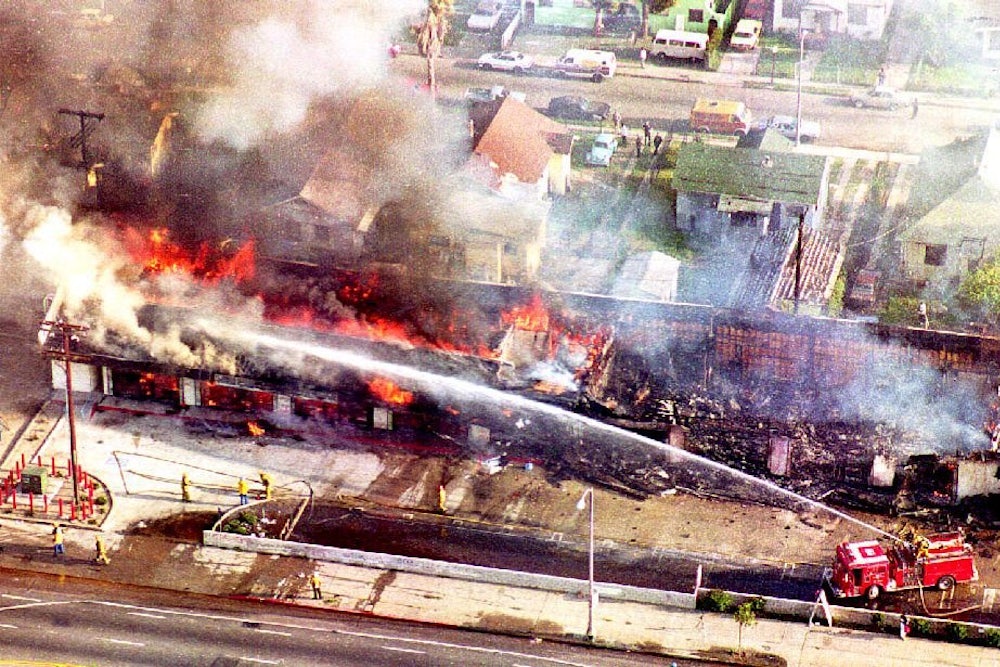Twenty-five years is a full cultural cycle. A baby born in 1992 is now a fully grown adult. The early ‘90s fashion revival has already come and gone. Although many things have not changed, including the default expectation of American police brutality against black people, the “look” of events on television from 25 years ago has now been codified into something we might call the visual history of a nation.
Several new documentaries out this weekend mark a quarter-century since the Los Angeles riots of 1992, which were sparked after a jury acquitted a group of police officers who the previous year had been caught on videotape viciously beating Rodney King. The documentaries all recycle the same canonical video clips in telling the old story, presenting an opportunity to reflect on the way that American history has existed onscreen during the lifespan of America’s youngest adults.
Notable among the documentaries are ABC’s Let it Fall, which airs tomorrow, a fulsome and investigative piece directed by John Ridley, the Oscar-winning screenwriter of 12 Years A Slave. It relies on archival news footage, interspersed with talking heads who were in L.A. at the time, including a woman who witnessed the murder of Latasha Harlins by a Korean-American store owner from a distance of around five feet. Then, on Sunday, National Geographic will debut LA ‘92, which sutures together television clips from the time, with no other content besides minimalist string music.
The famous pieces of footage are the same in each documentary, although of course framed differently (footage always has a frame). The fast-paced chants of “Guilty! Guilty!” outside the Simi Valley courthouse, where Rodney King’s assailants were acquitted. The helicopter videos of looting, timestamped 4/29/92 in the bottom right-hand corner. Those bloodied whites on the ground at that one intersection of 77th Street, first beaten by black people and then rescued by black people while the eyes in the skies looked on.
Flames. Korean store owners with guns in hand and looks on their faces as if this is a last resort and a sad one. A journalist, often a woman in a pastel suit, trying to report on the situation on the ground with a microphone in one hand and a finger in her ear. Behind microphones on podiums: Tom Bradley, Daryl Gates, Maxine Waters, President Bush.
Both documentaries are long, at around two hours. Both are characterized by grainy footage, shot by amateurs and TV stations. Rodney King’s beating is still extremely difficult to watch, the cops’ arms pumping up and down through the air.
King’s beating in real life was one thing, and on screen it was another. This is not to trivialize or make secondary his suffering: It was gratuitous and racist with a crude obviousness that is rarely legible in the racist scandals of our own moment. (LA ’92 makes a point of featuring the tapes of cops radioing each other, referring to King as a “lizard,” talking about “gorillas in the mist.”) But when George Holliday videotaped the police beating Rodney King, he jammed the clockwork of history to a stop.
Holliday happened to own a video camera light enough to lift and position on his own apartment balcony. His footage has become one of the classics—perhaps the American classic—of “sousveillance,” meaning a recording made from within daily life, rather than from above (like a closed circuit television camera).
The groundwork for his tape was laid over decades, not years, in the American media. In the 1970s and ‘80s, home video systems like VCR were marketed using a vocabulary of empowerment. Home taping promised Americans a mastery over the visual media they consumed that was previously withheld from them by the television networks. When light camcorders with their own microphones became affordable in the mid- to late ‘80s, two parallel genres sprang up, as if fully formed in the imagination of a TV executive: citizen journalism, where normal people recorded extraordinary events, and domestic footage shows, like America’s Funniest Videos, which debuted in 1989.
In 1980, covertly filmed videotape was admitted into an American court for the first time, as part of the ABSCAM case (the inspiration behind the movie American Hustle). That footage was used as evidence and later shown on television. As a direct result of the ABSCAM case, the verité look of shaky, handheld footage was already part of the fabric of American law. Michael Newman, the author of 2014’s Video Revolutions, records how in 1991 an Oklahoma television producer told the Columbia Journalism Review that amateur footage possesses “an unpolished quality that make it seem more real.”
Nothing could have felt “more real” than the videotapes that showed the murder of Latasha Harlins or the use of deadly force against Rodney King. In both Let It Fall and LA ’92, men and women on the streets of Los Angeles refer to “the videotape” as a kind of sacred object. In 1992, the American public consisted of the most experienced and expert viewers of videotape ever to have lived on earth. Despite the doubt cast on what was obvious to everybody but the predominantly white jury in the Rodney King trial, the videotape could not be altered.
Twenty-five years later, this piece of evidence, forged in a new and truly American medium, has special resonance. In our own moment, it can feel as though the government has some kind of monopoly on the truth, as if the right wing can gerrymander the very principles of reality. Our president lies and does not show the shame of a man caught lying. The documentaries commemorating the 25th anniversary of the L.A. riots therefore contribute something crucial to contemporary culture. They are not elegiac looks at the past, but tributes to the importance of visual evidence in cultural politics. That importance needs re-asserting now, as our faith in the idea of a shared truth weakens.
